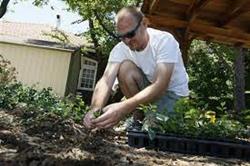Gardening Outlook for this Spring

Our area finally received some much-needed precipitation the last few weeks, following almost a year of near-drought conditions. Our subsoil was so dry in fact, that much of the heavy precipitation we received soaked in hardly any time at all, making it tempting to begin some early season gardening activities. The outlook looks quite favorable in terms of avoiding hard freezes and precipitation in the short term, but just a reminder that the average spring frost-free date for this part of the world is not until around the last week of April/first week of May, so keep that in mind as you plan ahead. Also, it is still quite early so at this stage in the season, if soil condition is still marginal, it is usually best to wait it out as working wet soil will leave clods and a layer of compaction that roots will struggle to penetrate. Having good root proliferation throughout the soil profile is very beneficial for water and nutrient uptake.
As you prepare the soil for your garden crops, you should also apply any fertilizer you will need for the season. If manure or compost was used in the fall then the required nutrients should be available for the upcoming season. Commercial fertilizer is also a good option. Having soils tested and knowing what crops will be planted, can give you a better idea of how much fertilizer to apply but a general recommendation for nitrogen would be 1.5-2.0 lbs. /1000 sq. ft. The recommended amount of phosphorus (P) and potassium (K) fertilizers to apply would be around 1.0 lb. of P / 1000 sq. ft. and 2.0 lbs. of K / 1000 sq. ft.
One other consideration before planting is soil pH. Most crops like a pH of 6.0 to 6.8, but there are some species such as potatoes that prefer more acidic conditions. Consider adding lime to raise the pH or sulfur to lower the pH depending on your soil test results and desired crop. It is the pH of the soil that will determine whether or not the nutrients in the soil will be available for plant uptake. It is also important to remember that it is not air temperature that determines when the optimal planting window is, rather soil temperature. Most seeds that are planted in the garden or in the field require a minimum soil temperature of 50°F to germinate.
There are several vegetable crops that are more cold-tolerant than others including: Spinach, Radishes, Peas, and Lettuce. These crops can be planted as early as late March depending on temperature and weather. Other vegetable crops that can be planted from early to mid-April include: Beets, Broccoli, Cabbage, Carrots, Cauliflower, Potatoes, Onion, and Turnips. The later phase of vegetable crops that would be planted around the mid-May time frame would include: Cucumber, Muskmelon, Peppers, Squash, Sweet corn, Tomatoes, and Watermelon. For more information on planting dates and garden tips check out the Purdue Extension publication “Home Gardener’s Guide” at http://www.hort.purdue.edu/ext/ho-32.pdf .

